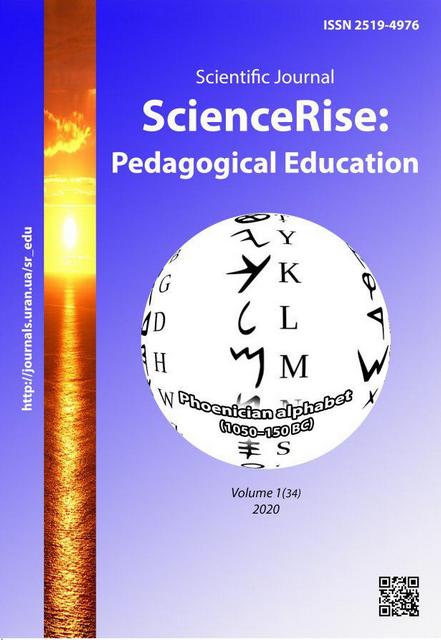Teachers’ readiness to create the inclusive and computer-orientated environment at primary school
DOI:
https://doi.org/10.15587/2519-4984.2020.192834Keywords:
educational environment, inclusive and computer-orientated environment, information and communication technology, psycho and pedagogical needsAbstract
The article deals with peculiarities of training specialists to create the inclusive and computer-oriented educational environment. A number of structural components that take a crucial system-forming role are highlighted in the article, namely a system of basic and professional future teachers’ values in inclusive education, practical potential, resource support for correctional and development activities and professional skills in the field of information and communication technologies and willingness to participate in e-education.
Research methods: psychological and pedagogical experiment, providing the qualitative and quantitative analysis of results, observations, questionnaires, interviews, modeling method and mathematical statistics.
The aim of the research work is to substantiate the structure and content of the inclusive and computer-orientated educational environment that will identify priority areas and activities in educational establishments and trace the range of professional competencies as a basis for working out a special course on syllabus.
The research work was carried out. It dealt with process of training future teachers to use electronic educational resources in the inclusive environment (to work in a team, implementing a comprehensive approach to educate a child with special educational needs, as well as to carry out diagnostic-advisory and pedagogical support). All mentioned above involved the students in studying the educational discipline.
Research findings on training future teachers to work in the inclusive educational and computer-orientated environment indicate that the competencies that are formed are rather satisfying, but there are certain aspects that teachers need to focus on, these are information and communication technology opportunities, they can use at work
References
- Lorman, T., Deppeler, D., Kharvi, D. (2010). Inkliuzyvna osvita. Pidtrymka rozmaittia u klasi. Kyiv: SPD-FO I. S. Parashyn, 296.
- Kozak, M. Ya. (2015). Normatyvno-pravove zabezpechennia inkliuzyvnoi osvity v Ukraini. Imidzh suchasnoho pedahoha, 3, 40–43.
- Polikhronidi, A. (2016). Stvorennia inkliuzyvnoho osvitnoho seredovyshcha v suchasnykh navchalnykh zakladakh. Nauka i osvita, 6, 82–85.
- Kolupaieva, A. (2014). Inkliuzyvna osvita yak model sotsialnoho ustroiu. Osoblyva dytyna: navchannia i vykhovannia, 2, 7–18.
- Kosova, K. O. (2013). Pidhotovka maibutnikh uchyteliv pochatkovykh klasiv do vykorystannia informatsiino-komunikatsiinykh tekhnolohii v umovakh inkliuzyvnoho navchannia. Kyiv, 20.
- Wendelborg, C., Tossebro, J. (2011). Educational arrangements and social participation with peers amongst children with disabilities in regular schools. International Journal of Inclusive Education, 15 (5), 497–512. doi: http://doi.org/10.1080/13603110903131739
- Chupakhina, S. V.; Zdanevych, L. V., Myskov, N. M., Pisotska, L. S., Reipovska, O. D. (Eds.) (2019). Stvorennia inkliuzyvnoho osvitnoho seredovyshcha v suchasnii shkoli: hotovnist maibutnikh pedahohiv. Zbirnyk naukovo-metodychnykh prats. Ch. II. Khmelnytskyi: KhHPA, 198–204.
- Demchenko, I. I. (2013). Alhorytm kvaziprofesiinoi pidhotovky maibutnoho vchytelia pochatkovykh klasiv do roboty v umovakh inkliuzyvnoi osvity. Psykholoho-pedahohichni problemy silskoi shkoly, 45, 40–49.
- Inkliuzyvne osvitnie seredovyshche: [za materialamy ofits. Internet-predstavnytstva Prezydenta Ukrainy] (2017). Metodyst, 6, 4–6.
- Shevtsiv, Z. M. (2017). Vplyv zakonodavchoi bazy inkliuzyvnoi osvity na pidhotovku maibutnoho vchytelia do roboty v inkliuzyvnomu seredovyshchi zahalnoosvitnoho navchalnoho zakladakh. Narodna osvita, 2 (32), 10–16.
Downloads
Published
How to Cite
Issue
Section
License
Copyright (c) 2020 Svitlana Chupakhina

This work is licensed under a Creative Commons Attribution 4.0 International License.
Our journal abides by the Creative Commons CC BY copyright rights and permissions for open access journals.
Authors, who are published in this journal, agree to the following conditions:
1. The authors reserve the right to authorship of the work and pass the first publication right of this work to the journal under the terms of a Creative Commons CC BY, which allows others to freely distribute the published research with the obligatory reference to the authors of the original work and the first publication of the work in this journal.
2. The authors have the right to conclude separate supplement agreements that relate to non-exclusive work distribution in the form in which it has been published by the journal (for example, to upload the work to the online storage of the journal or publish it as part of a monograph), provided that the reference to the first publication of the work in this journal is included.








